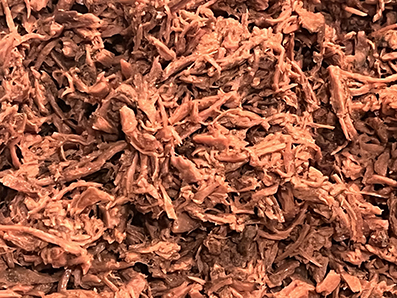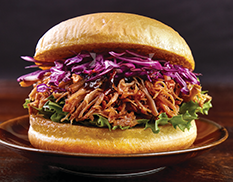

Protein Pioneer: Kesha Stickland
From a shared kitchen to a modular ingredient platform, The Mushroom Meat Company is quietly reshaping the future of food. CEO Kesha Stickland explains how fungi, foresight, and clean-label conviction are changing what’s on our plates
“Few really understand the power of what we’re doing,” begins Kesha Stickland, Co-founder & CEO of The Mushroom Meat Company, with calm conviction. “Or the massive potential we have to change alt protein into something that isn’t alternative at all, but just another center of the plate.”

It’s a bold statement, made not in a moment of bravado, but one of reflection. Stickland’s journey into the world of food innovation is rooted in necessity, shaped by software architecture, and fueled by her love of mushrooms. Her venture doesn’t just defy convention – it questions the very assumptions the industry was built upon.
But her path into the food space wasn’t paved by PhD studies or venture-backed ambition. It began in recovery. “About 10 years ago, I was in a major car accident,” she recalls. “Doctors gave me cortisone shots, muscle relaxants, painkillers and other medications – nothing really worked. Eventually, I was later diagnosed with Hashimoto’s disease.”
The search for healing led her to a naturopath and, soon after, to whole plant foods and functional mushrooms. But the real inflection point came not in the clinic, but at the dinner table – where daily choices took on new meaning.
“We had made this big family lifestyle shift,” she recalls. “But suddenly we didn’t know what to eat. What do you make for dinner when meat has always been the centerpiece?”
This shift from supplement to staple is more than a catchy tagline. It signals a foundational change in how mushrooms are positioned in the broader food landscape
Stickland, a self-described fermentation hobbyist, took matters into her own hands – literally. She learned to grow mushrooms, took culinary classes in her ‘spare time’, and eventually converted her garage into a fermentation lab.
The pivotal insight came from her children’s lukewarm response to her use of mushrooms in place of meat. “I had this profound but simple thought,” she says. “What if our mushroom supplement could be our meat? Or what if our meat was our mushroom supplement?”
Years of fermentation experience taught Stickland that microbes and fungi were often more responsible for the flavors and textures she and her family missed than the animal-based foods, like cheese and meat, they’d given up.
It wasn’t a leap toward entrepreneurship, at least not right away. It was simply a leap toward solving the nightly dinner dilemma without compromising on flavor, nutrition, or ethics. But, as Stickland points out, once you have an idea that works, it’s hard not to think bigger.
She began mapping out nutritional profiles, researching FDA labeling guidelines and ultimately refining her process into something scalable. That discipline came not from culinary school or her training in mushroom cultivation, though, but from her years in tech. “I approached it as any software product manager would,” she reveals. “I wanted to create something that people actually needed.”

as tacos
From hypothesis to company
The Mushroom Meat Company ultimately emerged not from forecasting or investor decks but from a constraint: how to deliver a satisfying, health-forward meat alternative without relying on protein isolates or ultra-processed ingredients. “I had already submitted a research proposal to the National Science Foundation through a previous software startup,” Stickland explains. “So, my husband said, ‘Why not apply again?’ I submitted a three-page pitch and within days, they wanted a full proposal.”
That proposal turned into a year-long research project – and ultimately, a business. Today, The Mushroom Meat Company operates as a B2B food-service startup, creating pork and beef alternatives using mushrooms and whole plant ingredients. “We like to say we’re moving mushrooms from supplements to center stage,” Stickland says.
This shift from supplement to staple is more than a catchy tagline though. It signals a foundational change in how mushrooms are positioned in the broader food landscape. Instead of being confined to capsules or powdered blends, mushrooms are taking their place in the culinary spotlight.
It also reflects a broader societal trend: consumers are increasingly looking for functional foods. The blurring of boundaries between nutrition and medicine is creating space for a new kind of product – something The Mushroom Meat Company appears in a prime position to deliver.
Whole foods, not wishful thinking
Unlike many of its plant-based peers, though, The Mushroom Meat Company avoids the twin traps of over-processing and nutritional compromise. The goal isn’t to mimic meat at any cost.
“Since the beginning, the industry has been asking consumers to choose between two extremes,” says Stickland. “You could have something meat-like but ultra-processed, or you could have a veggie burger that tasted like lentils and doesn’t satisfy your cravings.”

strand integrity of shredded beef – without isolates, gums, or extrusion
Her strategy aimed at the elusive middle: a meat alternative that actually delivers on the health halo of plant-based eating, without alienating tastebuds or ingredient-conscious consumers. “We always believed consumers would start reading labels more closely. And they have,” she notes. “There’s been a clear backlash against ultra-processed foods, even within our category.”
Their magic formula? Fewer than 10 ingredients. No gums. No methylcellulose. No ‘natural’ flavors. Just functional mushrooms, upcycled seeds, herbs, and other whole foods. And yet, the final product has fooled many a meat-eater, impressed chefs, and picked up multiple industry awards. “We accidentally became a meat analog,” Stickland laughs. “Having a product this close to meat was not the intent, but when the flavor and texture get close enough people just start comparing it to meat, regardless of what it’s made of.”
This raises an intriguing point: does the future of alt protein lie not in perfectly mimicking meat, but in offering an upgrade? One that satisfies on flavor, aligns with values, and leaves you feeling better afterward?
It’s also a response to growing label literacy. Consumers are scrutinizing not just the front of the pack, but the fine print. “We’re now in an age where transparency is currency,” Stickland says. “And the simplest way to be transparent is to use ingredients people already recognize.”
Constraint-driven creativity
What reads like a clean-label triumph is actually the outcome of disciplined, software-inspired strategy. Stickland describes their development philosophy as ‘constraint-driven innovation’. “It’s something I used to teach Fortune 500 companies,” she says. “Define your constraints – what you won’t use, what you can’t do. Then solve a specific problem inside that box. That’s where creativity lives.”
Texture is a prime example. “How do you get that dense, satisfying chew without gums or modified food starch?” she asks. “That limitation forced us to invent a new solution.” Flavor, she asserts, followed the same rules. No ‘natural flavors’, no synthetic boosters. Everything had to come from real food. It sounds idyllic, but the path was anything but straightforward.
No gums. No methylcellulose. No ‘natural’ flavors. Just functional mushrooms, upcycled seeds,
herbs, and other whole foods
“Our R&D lab was our kitchen. We brought fermentation tanks into shared kitchens and had to explain why we needed the space for three days straight. It was chaos. But it worked.”
Constraints aren’t just challenges for Stickland; they’re design principles. They define what is essential. “They give clarity. Without them, you end up chasing too many things. But when you know what you won’t do, you sharpen your focus.”
Platform thinking
Stickland’s background in tech not only shaped her process, but also her product strategy. “Modern software products are built on platforms composed of modular, reusable components. In food, platforms often refer to manufacturing hardware,” she says. “But for us, it’s about product architecture; ingredients that can be mixed and matched to create a variety of different products.”

Stickland created this modular system around a central component called ‘TMP’. “It’s our answer to TVP. It offers superior texture and can be shaped like just about any kind of meat, but the name is a bit of a misnomer. It’s not extruded and it’s made with one simple ingredient: mushrooms. We’ve also developed an ‘Umami Booster’ to enhance flavor while delivering authentic meaty taste. And we’re working on a fat component that behaves like beef and pork fat.”
Such modularity enables speed, flexibility, and cost-efficiency. “If we make a burger, we can easily spin it into sausage patties, meatballs, or ground pork,” Stickland explains. “Every problem is solved once and the solution gets reused. It also enables scalability. By not rebuilding the system every time we create a new product, that keeps development lean and helps with margins.”
This is platform thinking applied to protein production – and it represents a significant departure from the single-product obsession that has long dominated much of the alternative protein space. “The platform approach also lets us respond quickly to market feedback,” she says. “If a customer wants a new product format, we can iterate fast. That’s how we stay relevant.
Disruption by definition
“Disruption means solving a real-world problem in a fundamentally new and more effective way,” Stickland continues. “The belief has always been, you can’t do it with whole foods – that it’s not possible.”
However, Stickland has proven otherwise. “Once you show that it is possible, it forces others to rethink their assumptions. It resets consumer expectations and changes industries. That’s what real disruption looks like.”
As the backlash against processed plant-based grows, Stickland hopes clean-label analogs such as hers can reset consumer expectations. “You don’t have to choose between taste and health. That trade-off is no longer valid.”
Our R&D lab was our kitchen. We brought fermentation tanks into shared kitchens and had to explain why we needed the space for three days straight. It was chaos. But it worked
The company’s clean-label stance isn’t just a marketing point – it’s a philosophical one. “People are hungry for real benefits,” she says. “Not just fewer additives, but actual health benefits. Mushrooms offer that. They boost immunity, reduce inflammation, support gut health, and more. These are powerful drivers of behavior change.”
David and Goliath
Operating with limited capital has influenced and shaped nearly every aspect of how the business functions and makes decisions. “We’ve raised about a million dollars, but we’re competing with companies that’ve raised hundreds of millions,” Stickland says. “And yet, we haven’t lost a single sale to the big guys.”
Despite the challenges, though, being small has its advantages. It helps keep the team scrappy, highly agile, and tightly aligned around its objectives. It also protects against the kind of brand dilution that can often accompany scaling too quickly. “If we had taken on more VC money early on, I think we would’ve felt pressure to compromise,” Stickland reveals. “To cut corners on ingredients or process. But we haven’t had to do that.”
Ultimately, Stickland believes that staying lean has protected the integrity of The Mushroom Meat Company brand – as well as its future. “We run it like a software scrum team,” she says. “Daily check-ins, tight deadlines, and everyone wears five hats. But the most important part? We all believe in the why. That keeps us going.”
Scaling impact, not just output
So what’s next? Scaling production, strategic partnerships, and staying open to licensing or acquisition – but only if the mission remains intact.
“Some very big players have reached out,” Stickland acknowledges. A lot of them met the team through MassChallenge, the global, zero-equity startup accelerator that supports early-stage entrepreneurs across various industries. “Some of those talks are still ongoing,” she says.

For now, though, the focus is on meeting demand and building infrastructure incrementally. “Our model is sell, scale, sell, scale. We take just enough capital to fulfil the next wave of demand. Plus we’ve developed partnerships with large mushroom farms. We don’t do our own growing so our scaling costs are about one tenth of some other mycelium startups. This enables us to do more with a lot less.”
That bootstrapped mentality is not a shortcoming. It’s part of the brand’s DNA. “We only build what we need. We stay lean. We stay focused,” Stickland says. And what if the right partner should come along? “We’re open,” Stickland confesses. “But only if it helps bring our vision to life.”
Stickland doesn’t want to merely exist in the alt protein space. She wants to redefine it. “This industry needs change. And it doesn’t have to come from the usual suspects. It can come from a health-conscious, ex-software nerd mom solving the problems her own family faced.”
Her message to the industry is clear. “You don’t have to use protein isolates or additives. You don’t have to sacrifice health for functionality.” Real innovation, she feels, comes from listening. “When we listen to what people actually want – and not just what we think they should want – we build better products.” And sometimes, we build a better future. “I’m not looking to do this for the next 20 years,” Stickland concludes. “But I do want to make meaningful change. And I believe mushrooms can do that.”
If you have any questions or would like to get in touch with us, please email info@futureofproteinproduction.com







